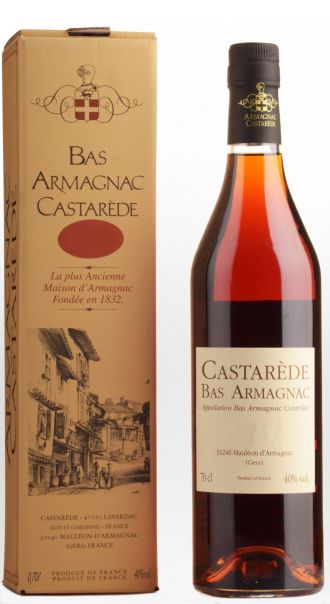Amber -bronze colour showing aromas ofmellow walnut, warm spices, cocoa and prunes. On the palate,delicious freshness and texture.
Delivery Charges
*Local Free Delivery: SL3 and SL4 postcode (Windsor/Datchet)
*Local Free Delivery: All SL (Except SL7), HP9, GU25, TW18, TW19 & TW20 postcodes. (Min. 6 bottles or 1 Hamper or 1 of our selected Wine cases purchased)
- England and Wales £12.00
- England and Wales Free Delivery (Over £200 purchased)
- Northern Ireland £30 (All BT postcodes)
- Scotland £15.00 (EH, FK, G, KA, KY, ML, DG and TD postcodes)
- Scottish Highlands and Islands £ 30.00 (All AB; DD; HS; IV; KW; KA27-28; PA; PH; TR21-25; ZE postcodes)
More Information
ArmagnacArmagnac is a grape brandy from the Gascony region of South-Western France. Its closest relative is cognac, another grape brandy from an appellation located about 100 miles north of Armagnac. Armagnac even though it is related to and often confused with cognac, armagnac is very different with regards to its grapes, terroir, distillation, élevage, blending, aromas, tastes and textures. In truth, France's two finest brandies made from wine are not very much alike at all.
Armagnac pre-dates cognac by about 150 years but never achieved the widespread sales figures that its relatives in the Charente obtained. Armagnac is made from distilled wine, and grapes are the first factor that gives it an original personality. Even though there are nine permitted varietals in Armagnac, four grapes are commonly used: Folle Blanche, Ugni Blanc, Colombard and Bacco. While these grapes ultimately give different aromas and flavours, they more importantly offer different weights and textures on the palate.
Folle Blanche
In pre-phylloxera days, the staple grape for armagnac was the Folle Blanche. Its light- to medium-bodied wine is low in alcohol (7%-9%) and high in acidity, making it less than ideal at the table but perfect for distillation into fine brandy. Armagnacs made from high percentages of Folle Blanche offer seductive characteristics; they tend to be feminine and show especially well in their first fifteen years of life. They normally have a very fine texture and light, high-pitched aromatics (including budding vine flowers, white peach, dried apricot and orange peel). Unfortunately, the precocious Folle Blanche (known as Gros Plant in the Loire) gives low yields, is prone to mildew and rot and today comprises less than 3% of total vineyard plantings. Folle Blanche can perhaps be viewed as the soprano of armagnac grapes.
Ugni Blanc
Ugni Blanc, known as Trebbiano in Italy, is most famous in the Charente where it comprises 98% of the Cognac vineyards. Ugni Blanc is relatively easy to grow and gives high yields-in short, a big producer and wonderful investment for growers. It produces wines with elevated levels of acidity and low alcohol, yet is fairly neutral in taste. Ugni Blanc now comprises about 55% of the grapes used for the distillation of armagnac. At their best, armagnacs made with Ugni Blanc contain pleasing floral aromatics that tend to accentuate the spice notes from the oak in which they are aged. They are less powerful and less flamboyant than Bacco and, in comparison with Folle Blanche, less aromatic and less fine.
Colombard
After distillation, Colombard's youthful aroma is slightly herbal and reminiscent of freshly mown hay. It never seems to develop the round flavors of Bacco or the delicate floral notes of Folle Blanche, nor does it provide the neutral foundation of Ugni Blanc. While the tenor is especially renowned in the opera world, it is not in Armagnac. Most of the Colombard now makes its way into the region's delightful Côtes de Gascogne wines.
Bacco 22-A
Bacco 22-A is a hybrid between Folle Blanche (a grape of the vinifera family) and Noah, a Labrusca grape. It was developed after the phylloxera and was very resistant to rot and mildew. It dominated the Armagnac vineyards between its invention in the 1920's and the 1970's, and most armagnacs on the market from that period are made with an overwhelming percentage of Bacco (occasionally spelled Baco). The end of Bacco is imminent, however, as the AOC board has decided hybrids will no longer be allowed within AOC regions after 2010. Obviously the bass, Bacco delivers an armagnac that is full-bodied, with plenty of fat and volume. With some age, it expresses itself with jammy dried plum notes, yet it can be somewhat rustic and lack finesse.
The Soils
Armagnac is divided into three sub-regions, the Bas-Armagnac, the Ténerèze, and the Haut-Armagnac.
Bas-Armagnac
The Bas-Armagnac (lower-Armagnac) is named for its lower altitude, rather than lower quality. The highest number of quality-oriented producers is located in the North-Western portion of the Bas-Armagnac, specifically in the département of Les Landes. This region, unofficially known as the Grand Bas-Armagnac, has sand-based soil, often with a high iron content (sables fauves) or with small pieces of clay (boulbènes) that tend to yield spirits that are very supple in their youth. The Bas-Armagnac is dominated by Bacco and Ugni Blanc plantings.
Ténaréze
While several excellent independent producers exist in the Ténaréze, this central region is home to most of Armagnac's négociants. The soil base in the Ténarèze is harder (clay and limestone) giving spirits that are firmer in their youth. Spirits from the Ténarèze, However, generally have the ability to age longer than those from the Bas-Armagnac. Plantings are dominated by Ugni Blanc and Colombard, and many farmers divert a good portion of their crop into excellent Côtes de Gascogne wines or Floc de Gascogne, the region's equivalent of Pineau des Charentes.
Haut-Armagnac
While the Haut-Armagnac comprises nearly 50% of the Armagnac region and is the most visually compelling, one is hard-pressed to find any vines among its rolling hills. Only a handful of independent producers still exist, and the region's limestone soils generally give spirits that are both flat and hard.
The Distillation Method
For the distillation of armagnac, the main objective is to heat wine until it boils, purely condense its vapours, and finally reconvert this steam into liquid form again. Traditional armagnac is distilled once in a small continuous still called an alambic, which is often transported from one producer to the next between the months of November and January. Unlike a double distillation pot still that eventually heats wine to around 72% (144 proof), the armagnac alambic issues a spirit between 52% and 60% (104 and 120 proof).
First, the wine enters the fire-driven alambic and is warmed in a pre-heater. From there it passes into the main column where it cascades over a number of heated plates. When it reaches the lower boiler, it begins to steam and evaporate. The alcoholic vapours then rise back through the curved tubes within the plates, forcing the outgoing eau-de-vie into contact with the incoming wine and insuring that additional fruit elements and flavours are transferred to the spirit. Finally the vapours exit through the top of the column and into the condensing coil, where they are cooled from steam into liquid form before dripping into a wooden cask.
This lower-alcohol spirit retains many esters, acids and congeners that double distillation purifies or eliminates altogether. In their youth, these non-alcohols can make the spirit thick, rustic and slightly foxy. Given time these elements oxidize and gain tremendous aromatic complexity. One needs, however, at least 12-15 years of patience.
Unfortunately, the commercial market demands products that are young and inexpensive. Therefore, the blends of many négociants (3 Etoiles, VSOP, Réserve, Hors d'âge) incorporate a percentage of double distillation (reinstated in 1974) which permits the removal of the non-alcohols and ultimately yields a lighter, more neutral and consumer-friendly spirit that can hit the market after only several years.
Ageing
Armagnac is traditionally aged in a 400-420 litre oak cask known as an une pièce armagnacaise. Armagnac barrels were originally Gascon oak, but the lack of natural resources now warrants an increased usage of oak from the Limousin forest. The differences between the two types of oak are not tremendous: Gascon oak tends to give more tannin, Limousin more vanilla. Adjusting time levels in newer and second-use oak can compensate for each barrel's physical differences.
Blended Armagnacs
Blended armagnacs can be a mixture of various vintages, various properties, various sub-regions and various distillation types. They are very frequently adjusted in one way or another by an enologist to promote colour and taste consistency. As in cognac, the goal is to standardize releases so that a VSOP or XO released in 1993 tastes the same as a VSOP or XO released in 1998.
For the mainstream, commercial market (supermarkets, convenience stores, sports bars), there are various categories that describe minimum ages for armagnac blends. These include 3 Étoiles (3 stars), which must be at least two years old, VSOP or Réserve, which must be five years old, Napoléon, Vieille Réserve or XO, which must be six years old, and Hors d'âge, which must be 10 years old. Occasionally these blends contain armagnacs that are older than the minimums, but they do not normally vary from their requirements by more than a few years.
Vintage armagnacs can usually be found in upscale wine stores and restaurants. They must come entirely from the vintage listed on the label. As armagnac matures only in cask and not after being bottled, vintages must also state the bottling date on the front or back label. In this way, one is generally assured of the spirits exact age.











